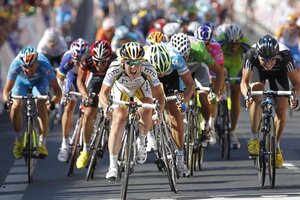Tour de France 101: Where does it go?
This year's Tour de France is considered one of the toughest in years, including two ascents of the notorious Col du Tourmalet in the Pyrenées.

Mark Cavendish of Britain crosses the finish line to win the fifth stage of the Tour de France cycling race over 187.5 kilometers (116.5 miles) with start in Epernay and finish in Montargis, eastern France, July 8, ahead of Sebastien Turgot of France, far left in blue, Jose Joaquin Rojas of Spain, left behond Cavendish, Gerard Ciolek of Germany, right behind Cavendish, and Edvald Boassson Hagen of Norway, far right.
Bas Czerwinski/AP Photo
This year's Tour de France is considered one of the toughest in years, giving an advantage to cyclists who excel in the tough mountain stages. The stages include climbs that are ranked 4, 3, 2, 1, or HC, with 4 being the easiest. HC stands for "hors catégorie" – ascents so tough they're beyond categorization.
But it's not all mountain stages. There's still a little of everything, giving an opportunity for a variety of riders to shine. Here's a taste of the course, which goes clockwise around France.
For climbers: This year’s Stage 9 includes a nearly 18-mile climb that begins just past the 1992 Olympic village of Albertville and ends at the Col de la Madeleine.
For daredevils: Stage 13, a net downhill that ends in the eight-time Tour host village of Revel, favors what French call a baroudeur – a breakaway artist.
Gutsy riders who have an eye for the best line relish days that end with a ripping descent, such as Stage 15 in the Pyrenées.
For winners: But it’s on squiggly, windy roads such as the that ascends the Col du Tourmalet, an HC climb, that the race is really decided. This year, riders must climb the pass twice – once from each direction. The second time, on Stage 17, they climb 3,000 feet in just over seven miles.
For time trial specialists: Once everyone’s legs are fully rubberized, they’ll tackle the flat-as-a-crêpe Stage 18. But the real test of mental stamina comes in the following stage, a “time trial” where each rider races alone against the clock.
For the fans: Then it’s all about holding on until the Eiffel Tower comes into view, with the grande finale coming on the Champs Elysées and finishing – naturally – just in front of L’Arc de Triomphe.
Related:
